
Cathedrals, collegiate churches, and monastic churches like those of abbeys and priories, often have certain complex structural forms that are found less often in parish churches. They also tend to display a higher level of contemporary architectural style and the work of accomplished craftsmen, and occupy a status both ecclesiastical and social that an ordinary parish church rarely has. Such churches are generally among the finest buildings locally and a source of regional pride. Many are among the world's most renowned works of architecture. These include St Peter's Basilica, Notre-Dame de Paris, Cologne Cathedral, Salisbury Cathedral, Antwerp Cathedral, Prague Cathedral, Lincoln Cathedral, the Basilica of Saint-Denis, Santa Maria Maggiore, the Basilica of San Vitale, St Mark's Basilica, Westminster Abbey, Saint Basil's Cathedral, Antoni Gaudí's incomplete Sagrada Família and the ancient cathedral of Hagia Sophia in Istanbul, now a mosque.

St. Mary's Church, Walthamstow, is a Church of England parish church in Walthamstow Village, a conservation area in Walthamstow, east London. It was founded in the 12th century and is still a working church with a cafe, Play Area and Exhibition Space open during the week. St Mary's also hires rooms and spaces in both the church and nearby St Mary's Welcome Centre to outside groups. It retains over one hundred and fifty brasses and monuments, the oldest dating from 1436, though all that now remains of the original Norman church is some pillar bases and the chisel marks on them. In 2021-2022, the church was extensively renovated with support from the National Lottery and now includes a modern extension which contains the Parish Office and an Exhibition Space.
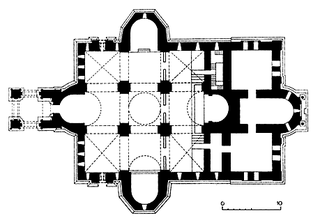
Church architecture refers to the architecture of Christian buildings, such as churches, chapels, convents, seminaries, etc. It has evolved over the two thousand years of the Christian religion, partly by innovation and partly by borrowing other architectural styles as well as responding to changing beliefs, practices and local traditions. From the Early Christianity to the present, the most significant objects of transformation for Christian architecture and design were the great churches of Byzantium, the Romanesque abbey churches, Gothic cathedrals and Renaissance basilicas with its emphasis on harmony. These large, often ornate and architecturally prestigious buildings were dominant features of the towns and countryside in which they stood. However, far more numerous were the parish churches in Christendom, the focus of Christian devotion in every town and village. While a few are counted as sublime works of architecture to equal the great cathedrals and churches, the majority developed along simpler lines, showing great regional diversity and often demonstrating local vernacular technology and decoration.

Peterchurch is a village and civil parish in the Golden Valley, Herefordshire, England. The countryside around is spectacular, with views of the Black Mountains but the village itself is architecturally undistinguished, except for the award-winning 'church reordering' scheme within the Norman church, carried out in 2012 by the Herefordshire-based architects Communion Design.
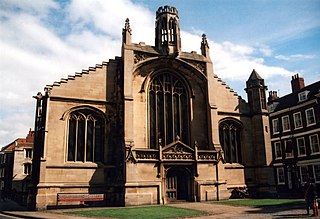
St Michael le Belfrey is an Anglican church in York, England. It is situated at the junction of High Petergate and Minster Yard, directly opposite York Minster, in the centre of the city.

St Peter's Church is an inclusive Anglican parish church in Walworth, London, in the Woolwich Episcopal Area of the Anglican Diocese of Southwark. It was built between 1823–25 and was the first church designed by Sir John Soane, in the wave of the church-building following the Napoleonic wars. It is the best preserved of Soane's churches.

St Mary's Church, Fetcham, Surrey, England is a Church of England parish church (community) but also refers to its building which dates to the 11th century, that of the Norman Conquest and as such is the settlement's oldest building. It is set off the residential road of its address, The Ridgeway, behind a small park, in the suburban part of the largely 20th century railway settlement adjoining the M25 London Orbital Motorway which has retained farmed rural outskirts. The closest secular building is Grade II* listed Fetcham Park House, which is in the same architectural category and the church has an adjoining church hall.

St Thomas the Martyr is a former Church of England parish church on St Thomas Street in the Redcliffe district of the English port city of Bristol.

The medieval cathedrals of England, which date from between approximately 1040 and 1540, are a group of twenty-six buildings that constitute a major aspect of the country's artistic heritage and are among the most significant material symbols of Christianity. Though diverse in style, they are united by a common function. As cathedrals, each of these buildings serves as central church for an administrative region and houses the throne of a bishop. Each cathedral also serves as a regional centre and a focus of regional pride and affection.

A redundant church, now referred to as a closed church, is a church building that is no longer used for Christian worship. The term most frequently refers to former Anglican churches in the United Kingdom, but may also be used for disused churches in other countries. Redundant churches may be deconsecrated, but this is not always done.
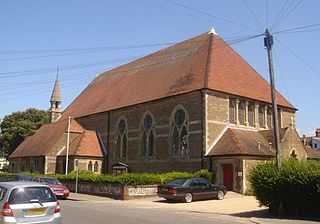
St George's Church is an Anglican church in the East Worthing area of the borough of Worthing, one of seven local government districts in the English county of West Sussex. Built in 1867–68 to serve new residential development in the southeast of the town, the Decorated Gothic-style structure was extended later in the 19th century, and expanded its reach further by founding three mission halls elsewhere in Worthing. English Heritage has listed it at Grade C for its architectural and historical importance.

St John the Evangelist's Church is a redundant Anglican church in North Road, Lancaster, Lancashire, England. It is recorded in the National Heritage List for England as a designated Grade II* listed building, and is under the care of the Churches Conservation Trust.
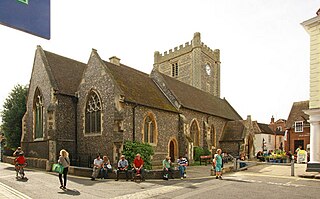
St Mary-le-More is a Church of England parish church in Wallingford, Oxfordshire, England. The church is situated in the centre of The Marketplace, just behind the Town Hall.

The Barn Church, Kew, formally known as St Philip and All Saints, is the first barn church to be consecrated in England. The building, which is not listed, is on the corner of Atwood Avenue and Marksbury Avenue, in an area previously known as North Sheen and now in Kew, in the London Borough of Richmond upon Thames. It was constructed in 1929 from a 17th century barn from Oxted in Surrey. The west end was converted in 2002 into a large parish room with a gallery above looking down the length of the building. The sanctuary was refurbished and remodelled in 1998.

St Mary's Church is in the town of Windermere, Cumbria, England. It is an active Anglican parish church in the deanery of Windermere, the archdeaconry of Westmorland and Furness, and the diocese of Carlisle. Its benefice is united with that of St Martin's Church, Bowness-on-Windermere; St Anne's Church, Ings; St Cuthbert's Church, Kentmere; St James' Church, Staveley and Jesus Church, Troutbeck. The church is recorded in the National Heritage List for England as a designated Grade II listed building.
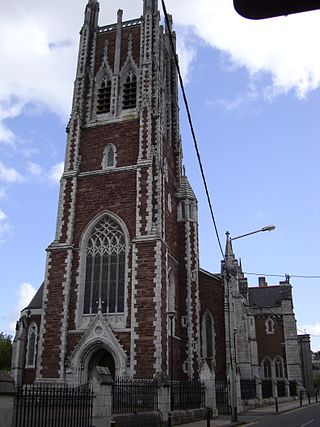
The Cathedral of Saint Mary and Saint Anne, also known as Saint Mary's Cathedral, The North Cathedral or The North Chapel, is a Roman Catholic cathedral located at the top of Shandon Street in Cork, Ireland. It is the seat of the Bishop of Cork and Ross, and the mother church of the Roman Catholic Diocese of Cork and Ross. Its name derived from the fact that it encompassed the ecclesiastical parish of St. Mary and the civil parish of St. Anne.

St Grwst's Church, Llanrwst, is located in Church Street, Llanrwst, Conwy, Wales. It is an active Church in Wales parish church and is part of the Aberconwy Mission Area in the archdeaconry of St Asaph, and the diocese of St Asaph. Its benefice is united with those of Llanddoged with Capel Garmon, Llansanffraid Glan Conwy, and Eglwysbach. The church is designated by Cadw as a Grade I listed building.
Gerard Thomas Goalen was a British architect who specialised in church architecture and was influenced by continental models and the Liturgical Movement. He was one of the most important architects of the Catholic Modernist movement in the United Kingdom during the 20th century.

St Anne's Church is a heritage-listed Roman Catholic church located at 60 Blair Street, North Bondi, Waverley Municipality, New South Wales, Australia. The church was designed by Joseph Fowell and Kenneth McConnel, and built from 1934 to 1964 by R. M. Bowcock. It is also known as St. Anne's Church and St Anne's Shrine. The property is owned by the Sisters of Mercy and it was added to the New South Wales State Heritage Register on 26 May 2006.

All Saints Church is an Anglican church in the town of Winterton, England. It is recorded in the National Heritage List for England as a designated Grade I listed building. The church stands close to the center of the town within a Conservation Area, 6 miles (10 km) north of Scunthorpe, to the west of the A15 road. The church is a constituent of the Historic England Heritage at Risk Register and has a priority category of C, signifying slow decay.




















